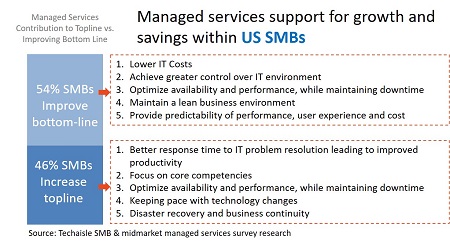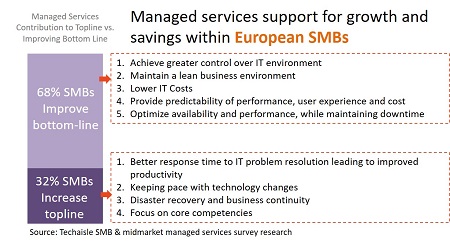US and European SMB buyers believe that managed services contribute to both cost savings and to business growth. As the figures below show, managed services is seen as helping buyers to achieve lower IT costs, greater control over IT environments, and higher performance with less IT downtime; managed services also helps businesses to “maintain a lean business environment” and to provide predictable performance, user experience and cost. On the growth side of the equation, superior (relative to internal options) MSP responsiveness to IT problems is seen as a means of achieving better productivity; MSPs are also seen as helping SMBs to maintain focus on core business competency, staying abreast of technology changes and providing support for business continuity and disaster recovery.
54% of US SMBs and 68% of Europe SMBs say that managed services help improve bottom-line, contribute to profitability and reduce costs. On the flip side, 46% and 32% respectively state that they view and have experienced managed services as a technology contributing to growth and revenue. A more detailed look at the data underlying this summary analysis illustrates the many benefits that SMBs obtain from managed services (and MSPs).


A glance at why managed services are in use provides clear insight into the motivations that are spurring expanding use. Both small businesses and midmarket companies consider security improvements and IT cost control to be important reasons for embracing managed services. Beyond these two issues, small and midsized companies have different reasons for pursuing services as a solution to current (or emerging) IT requirements.
Other top small business responses focus on the notion of control: achieving greater control over IT, improving IT problem resolution response time, improving the predictability of user experience, optimizing availability and performance.
In the midmarket – consistent with the thesis that managed services augments current activities – the research finds that managed services are primarily used to enhance IT management options. Key issues here include improving IT management processes, addressing a strong need to identify and fix problems before they occur (proactive management), reduction of IT and business risk, and improved disaster recovery/business continuity readiness. Figure 5 below shows that there are 15 different attributes cited by more than 10% of small and midmarket businesses as reasons for using managed services, corresponding to the cost and growth factors highlighted above.
Related research report deliverables:
360 on US SMB Managed Services Market - End-user & Channels
Europe SMB & Midmarket Managed Services Adoption Trends
US SMB & Midmarket Managed Services Adoption Trends
The SMB Channel and Managed Services: Success Metrics
The State of US SMB Managed Services Channel
US SMB Channel Partner Trends
Europe SMB Channel Partner Trends
Asia/Pacific SMB Channel Partner Trends
Latin America SMB Channel Partner Trends